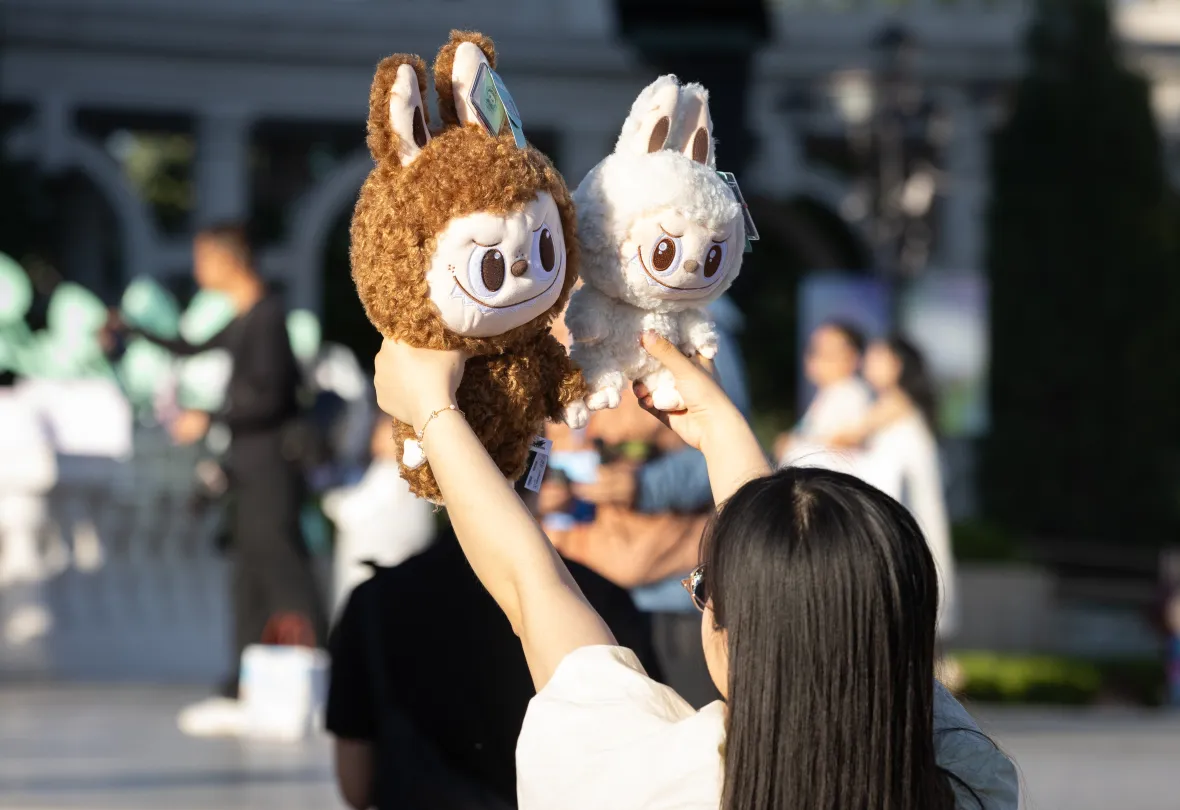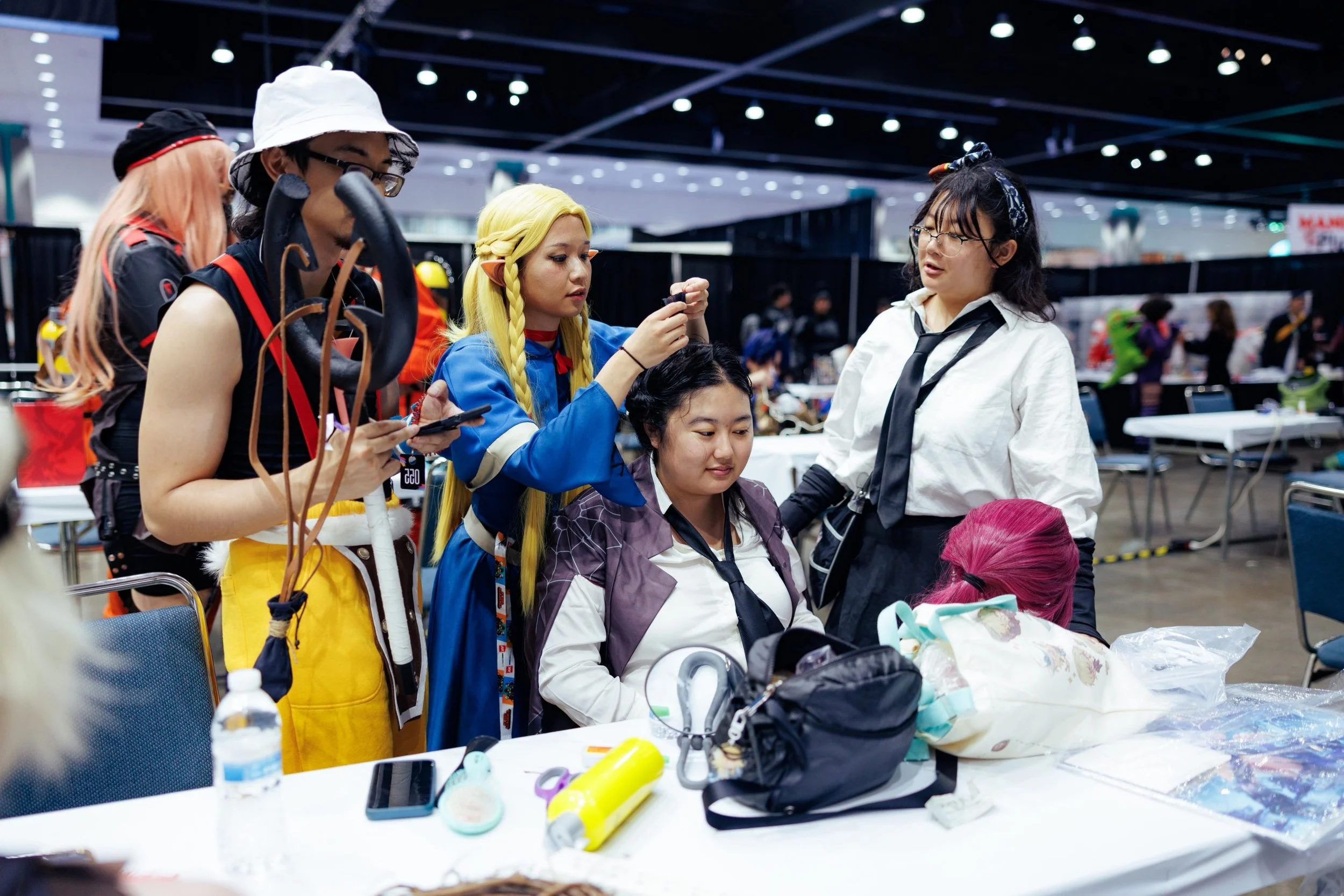Labubus, LARPing and The Radical Rise of Adult Play
EPA/JESSICA LEE
On a typical weeknight, whether in Brooklyn, Birmingham or Boise, a group of thirty-something professionals will huddle around a pub table rolling 20-sided dice, collectively slaying a pretend dragon. Across town, an “adult coloring” meetup in a public library will see men and women quietly filling intricate mandala pages with colored pencils. Scenes like these—grown adults indulging in play—might have drawn smirks a generation ago.
Today, they’re increasingly common. Millennials and Gen Z are reclaiming play, that most “childish” of behaviors, as a legitimate part of adult life. In doing so, they are challenging long-held assumptions about maturity. Reclaiming joy and imagination, it turns out, can be a quietly subversive act in a culture that has long equated adulthood with emotional austerity and ceaseless productivity.
This cultural shift didn’t happen in a vacuum. Economic precarity, shifting gender norms and evolving ideas about mental health have all played a role in the rise of adult play. From the explosive popularity of cosplay conventions and Dungeons & Dragons campaigns to the boom of Labubu, Jellycat and Squishmallow collectors, adults are choosing hobbies that would once have been deemed immature.
As author Adrienne Maree Brown argues, joy itself can be a form of resistance, a way to “explode the dour myth” that growing up means giving up feeling good. Indeed, forging space for pleasure and play can take power away from oppressive expectations and encourage others to do the same. What we are witnessing is a generational pushback against the iron cage of the work ethic–a politics of play that insists life is more than just toil and obligation.
All Work, No Play: A Brief History of Adult Austerity
Western culture has long trivialized play as something to be left behind in childhood. The modern work ethic, born of the Industrial Revolution and our Protestant ethos, taught that industriousness, self-denial, and productivity were the markers of moral adulthood. Play came to be seen as idle, wasteful or frivolous, an indulgence suitable only for kids or the occasional leisure hour carefully cordoned off for recuperation. The very language of maturity reflected this bias: Put away childish things, we tell the young as they come of age.
Under this mindset, adulthood was framed as a realm of seriousness and utility. A true grown-up devoted themselves to career, family duties and economic production; toys and games were for children, and any adult too interested in them risked being labeled as unserious.
In his book, The Play Ethic: A Manifesto for a Different Way of Living, author Pat Kane observes, ever since the 18th century, society has tried to “keep play’s unpredictable energies at bay” by confining play to brief, trivialized recesses (“recreation”) or by infantilizing it as an immature state one must “put behind” to be a “serious adult.” In short, I work, therefore I am became the mantra of respectable adulthood—leaving little room for I play, therefore I am.
The pressure to abandon play was reinforced by economic systems. In modern society, profit and productivity often overshadow human whimsy. Pleasure, rest and play have not been considered vital to adult life because labor and production are framed as our fundamental purpose.” If your value is defined by your output, then time “wasted” on non-productive fun can seem almost sinful, after all hustle culture leaves scant emotional permission for play.
It’s no wonder that the opposite of play has been famously described not as work, but as depression. Experts in the field of play science, led by figures like Dr. Stuart Brown, argue that play is not a luxury but a fundamental human need “deeply embedded in nature” and as essential as sleep. Findings published by the National Institute of Health (NIH) found play boosts creativity, cognitive development and emotional well-being at all ages. If anything, adults need play to relieve stress and protect their mental health, just as children need play to learn and grow.
Still, it has taken a new generation to begin eroding the stigma and to publicly declare that grown-ups, too, have a right to joy.
Cosplayers, Gamers & Kidults: Play Communities Redefining Maturity
From the outside, some adult play activities might look like pure escapism. Visit any large fan convention and you’ll see grown adults in elaborate costumes—wizards, fairies, Fornite and anime characters—gleefully role-playing and snapping selfies.
Log on to an online gaming forum and you’ll meet middle-aged professionals obsessing over the latest Pokémon release or spending weekends playing Minecraft. Peek into a “LEGO Adult Fans” group and you’ll find collectors in their 30s and 40s painstakingly assembling models, or lining up to buy the newest Star Wars set. These subcultures, often dismissed as nerdy or childish in the past, have now swelled into mainstream adult pastimes.
Take cosplay, for example. It’s no longer a niche oddity to see adults dressing up as fictional characters. Cosplay conventions attract thousands of attendees of all ages, not only in Tokyo or Los Angeles but in cities worldwide. Participants often speak of cosplay as liberating and empowering. It gives adults permission to pretend, experiment with identity and form bonds over shared imagination.
A group of cosplayers get ready at the 2024 Anime Expo
Far from indicating immaturity, these cosplayers often say the confidence and joy they gain spills over positively into their everyday lives. In challenging the notion that dress-up is “just for kids,” cosplayers are expanding what it means to be a mature adult—one can hold a job and pay the bills and occasionally don a cape and wig for fun.
Another striking example is the resurgence of Dungeons & Dragons (D&D) and other tabletop games among adults. D&D, a fantasy role-playing game invented in the 1970s, was once stereotyped as the domain of teenage boys in basements. Today, it is cool and its player base has broadened dramatically. Wizards of the Coast estimated a few years ago that some 50 million people have played D&D worldwide, with interest climbing year-over-year.
Importantly, many of those new players are adults in their 20s, 30s, and beyond, including many women. Now you can find D&D games in cafes, at workplace team-building retreats, even at trendy bars hosting “Drinks & Dragons” nights.
What changed? In part, broader culture shifted. Fantasy media went mainstream (thanks to Game of Thrones, Marvel superheroes and Stranger Things), removing the old stigma that fantasy is solely for basement dwellers. Joe Manganiello, an actor and ardent D&D fan, notes that “there’s an acceptance of geek culture now” in the mainstream.
But beyond that, people discovered (or rediscovered) that the game itself fulfills very human needs. D&D brings people together face-to-face in a world saturated with screens and solitary scrolling. It’s a chance to gather around a table, share stories, laugh and problem-solve, like humans have done around campfires for millennia. Now in workplaces and friend groups, it’s not unusual to hear someone casually mention their weekend D&D campaign. The notion that adults “don’t do that” is fading.
Even mental health professionals have taken note, with many recommending D&D as a tool to help build social skills or cope with anxiety. In one striking case, a U.S. Army veteran credited playing D&D with helping him process PTSD from combat, by working through emotions in a safe, imaginative space. These stories underscore how play can serve serious, even healing purposes for adults.
It’s not just niche subcultures, either. Entire industries have evolved to serve adults hungry for play. Adults have been the fastest-growing segment of the toy market in recent years, with teens and adults (age 12 and up) now accounting for 28.5% of all toy sales. LEGO, for instance, has a devoted following of adult builders (dubbed AFOLs, or Adult Fans of LEGO) and has released sophisticated sets—a 7,500-piece Millennium Falcon, a vintage Typewriter of Film Camera kit, an ornate Botanical Collection and a sprawling Hogwarts Castle—squarely aimed at 20- and 30-somethings with disposable income.
And the strategy is paying off: one report noted LEGO’s botanical flower kits led to “triple-digit sales uplift from 2019-2023 among 12+ females.” Major toy companies like Hasbro have similarly embraced this demographic, creating collectible lines and nostalgia products for the grown fans who never quite grew out of their favorite franchises.
Similarly, Build-A-Bear Workshop has leaned into the so-called "kidult" market. CEO Sharon Price John revealed that adults now make up nearly 40% of the brand’s customer base. From launching an 18+ 'Bear Cave' microsite to releasing limited-edition 'After Dark' bears aimed at older audiences, Build-A-Bear has fully embraced the emotional and nostalgic pull of play for adults. In a world where joy is scarce, more and more brands are learning that adults crave soft, silly, tactile moments of magic, too.
Courtesy of Build a Bear
Other trends abound. The mid-2010s saw an adult coloring book boom that took everyone by surprise. In 2015, some 12 million adult coloring books were sold in the U.S. alone.
For a time, adult coloring books crowded bestseller lists with titles promising stress relief through artistic play. Skeptics sneered that it was a regressive fad but fans argued (and psychologists concurred) that it was a simple, screen-free way to unwind and practice mindfulness. Libraries and community centers began hosting adult coloring clubs as low-pressure social gatherings where grown-ups could chat and color with crayons and coloring sheets. The phenomenon demonstrated that millions of adults were yearning for permission to do something calm, creative and seemingly purposeless, just for the joy of it.
In essence, play is being reframed not as a childish escapade, but as self-care, a way to balance the strains of adult life.
Resilience in a Precarious Age
It’s worth asking: Why are these generations in particular embracing play so ardently? Several factors converge. Millennials (born roughly 1980-1996) and Gen Z (1997-2010s) have come of age in an era of turbulence and uncertainty. Many entered adulthood during or after the Great Recession of 2008, only to be slammed a decade later by a global pandemic. They face massive student debt loads, soaring housing costs and a gig-based economy that often offers more instability than security. For many, the traditional markers of adult success, such as a stable career, home ownership and starting a family, have been delayed, denied or simply rejected.
As sociologist Jean Twenge observes, Millennials are “the first generation in American history in which the majority of 31 to 46-year-olds are not married,” and the average age of first childbirth has climbed to 30 (versus early 20s a few decades ago). Some are choosing to remain child-free altogether at higher rates than prior generations, citing not only personal preference but practical concerns: How can I raise a kid when I can barely afford rent? Is it responsible to bring children into a world of crisis and uncertainty? The net effect is that the path to what our culture considers “full adulthood” has stretched out and, in some cases, rerouted entirely.
In the meantime, these younger adults are forging a different kind of adulthood; one that often includes holding onto youthful passions. If you can’t bank on the future (financially or even existentially), there is a logic to seizing joy in the present. Play offers an immediate, accessible pleasure in a world of deferred dreams. It’s also a coping mechanism.
Mental health surveys consistently find that Millennials and Gen Z report higher levels of stress, anxiety and burnout than older generations did at the same age. They are sometimes unfairly dismissed as “fragile” or “lazy,” but in truth many are working harder and under more strain—juggling jobs, side hustles and constant connectivity—yet with less economic reward to show for it. The result: a yearning for genuine, unstructured play that can relieve the pressure.
Indeed, research confirms what these young adults intuitively know: play is a powerful tool for resilience. A 2022 psychological study published by the NIH found that among emerging adults (late teens to mid-20s), those who spent more time engaged in play had measurably higher emotional intelligence and stronger resilience against stress. Play experiences helped them cultivate positive emotions and coping skills, indirectly boosting their ability to handle life’s challenge. In short, playing doesn’t make young adults immature; it helps them survive and even thrive amid a very challenging environment.
The anecdotal evidence bears this out. For every comment section sneering about a 30-year-old man who plays Minecraft or collects Funko Pops there’s a story of someone whose hobby literally kept them alive or sane. The grieving mother who found solace in coloring books, the veteran who processed trauma through role-play, the shy newcomer in town who made friends by joining a local improv class—these are stories of resilience born from play.
During the pandemic lockdowns, sales of puzzles, board games and hobby kits went through the roof as people of all ages turned to old-fashioned play to get through isolation and fear. On social media, young people organized “virtual game nights” and TikTok dance challenges to stay upbeat. It became clear that play isn’t just a distraction from turmoil; it’s a way to build hope and community in dark times.
Moreover, Millennials and Gen Z bring a different ethos to work and life balance. Having seen their parents often work to the point of burnout (or lose jobs through recession layoffs), many have consciously rejected the idea that one’s job should consume one’s identity. The rise of “antiwork” sentiment and the valorization of self-care among younger people speak to a desire to reclaim time for living, not just working.
In this light, embracing play is almost a gentle rebellion. It’s saying: We refuse to accept that adulthood must be joyless. We will make time for the things that make us feel alive, even if they don’t earn a dime. Adulthood, after all, is hard enough; why strip it of the magic that made life sparkle when we were kids?
There is also a subtle political current here. Some commentators talk about a “play ethic” replacing the old work ethic. The play ethic doesn’t mean shirking responsibilities, but it does mean valuing creativity, flexibility and passion over blind toil. It imagines a society where people’s “passions and enthusiasms” are at the center of their lives, not relegated to the margins. Such an outlook views play as not the enemy of productivity, but as a source of innovation.
Finally, we must acknowledge the influence of the wellness movement and changing psychology around play. There’s been an explosion of books, apps and programs encouraging adults to be more mindful, more present, more joyful.
Corporate workplaces, too, have tried to harness play (sometimes superficially, with foosball tables and in-office slides) as a way to boost employee morale and creativity. While turning play into a corporate productivity hack can be cynically viewed as co-opting fun for profit, it nevertheless reflects a recognition that humans simply function better when they have joy in their lives.
Millennials and Gen Z, being generally more open about mental health, have taken this to heart. They speak openly about the need to unplug and do something fun as a form of self-maintenance. It’s common now to hear a young professional say, “Sorry, I can’t stay late, I have board game night” and for that to be respected, even admired, by peers.
Growing Up, Not Growing Away
In reclaiming play, today’s adults are crafting a new vision of maturity—one that is more balanced, humane and dare we say, more fun. This is not a peter-pan denial of growing up, but rather a reimagining of what growing up can mean. It means carrying our imaginative spark forward instead of snuffing it out. It means recognizing that wonder, creativity and yes, playfulness, are not traits to be shamefully hidden in adulthood but strengths to be cultivated. In a society that often asks people to harden themselves, to “grind” and consume until they burn out, choosing to play is indeed a quietly radical choice.
The stakes, however, go beyond individual happiness. When a generation reclaims play, they implicitly demand a society that makes room for happiness and humanity. It calls for workplaces that recognize employees are people with passions outside the office. It calls for valuing caretaking, art and leisure in economic policies. And finally, it asserts that we are human beings, not just human doings, and that our lives deserve moments of unproductive delight.
We want to hear from you. How are you incorporating play into your adult life? What rituals, hobbies or forms of joy are helping you grow into the most expansive version of yourself? Submit your stories to HYVEMIND, because your version of adulthood is worth archiving.






